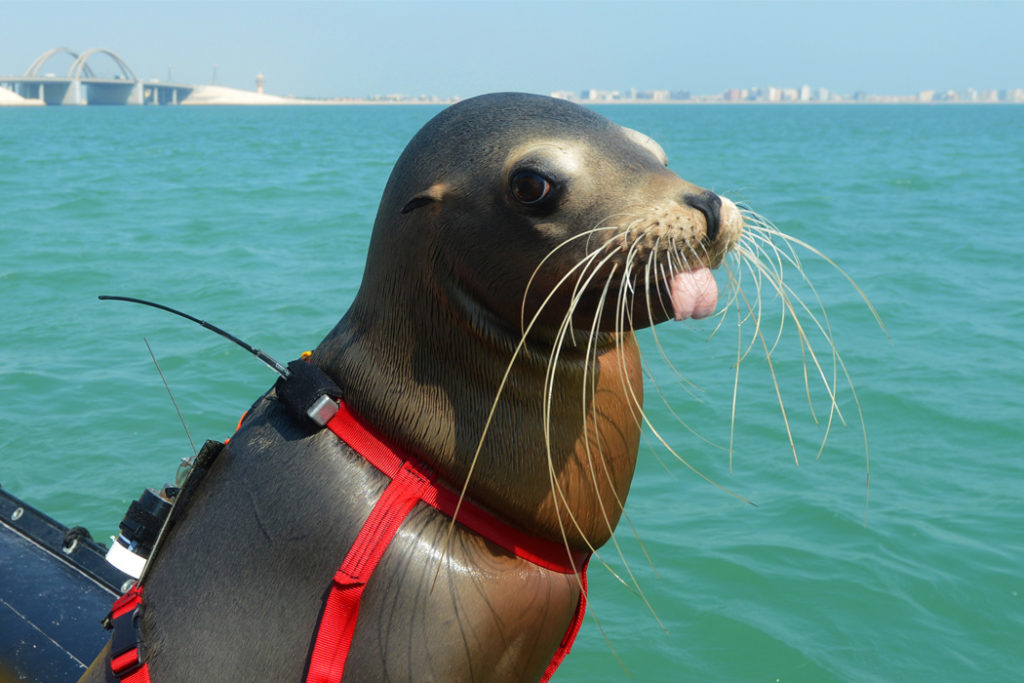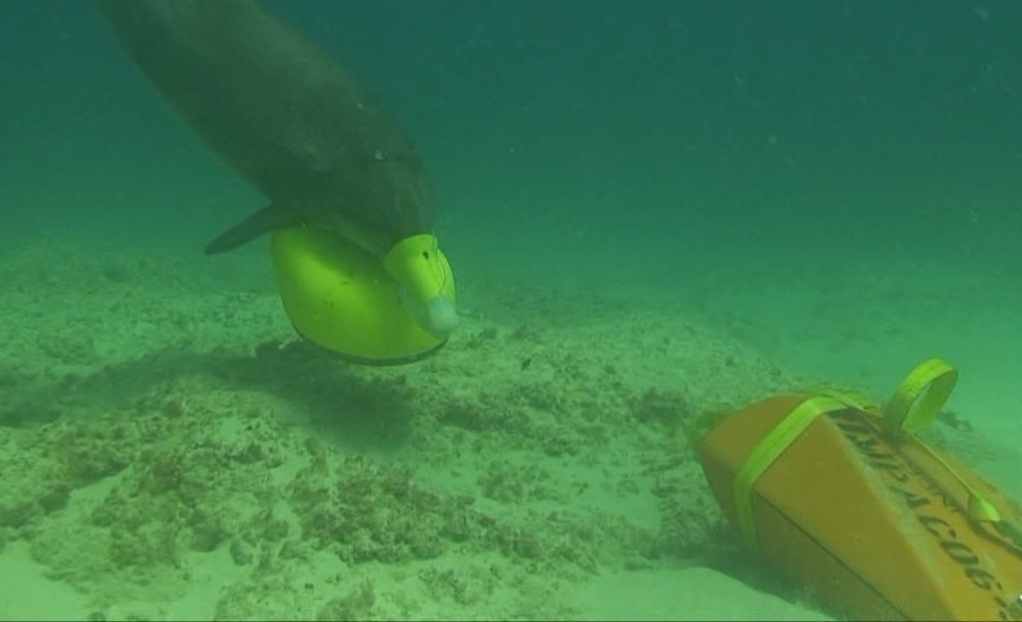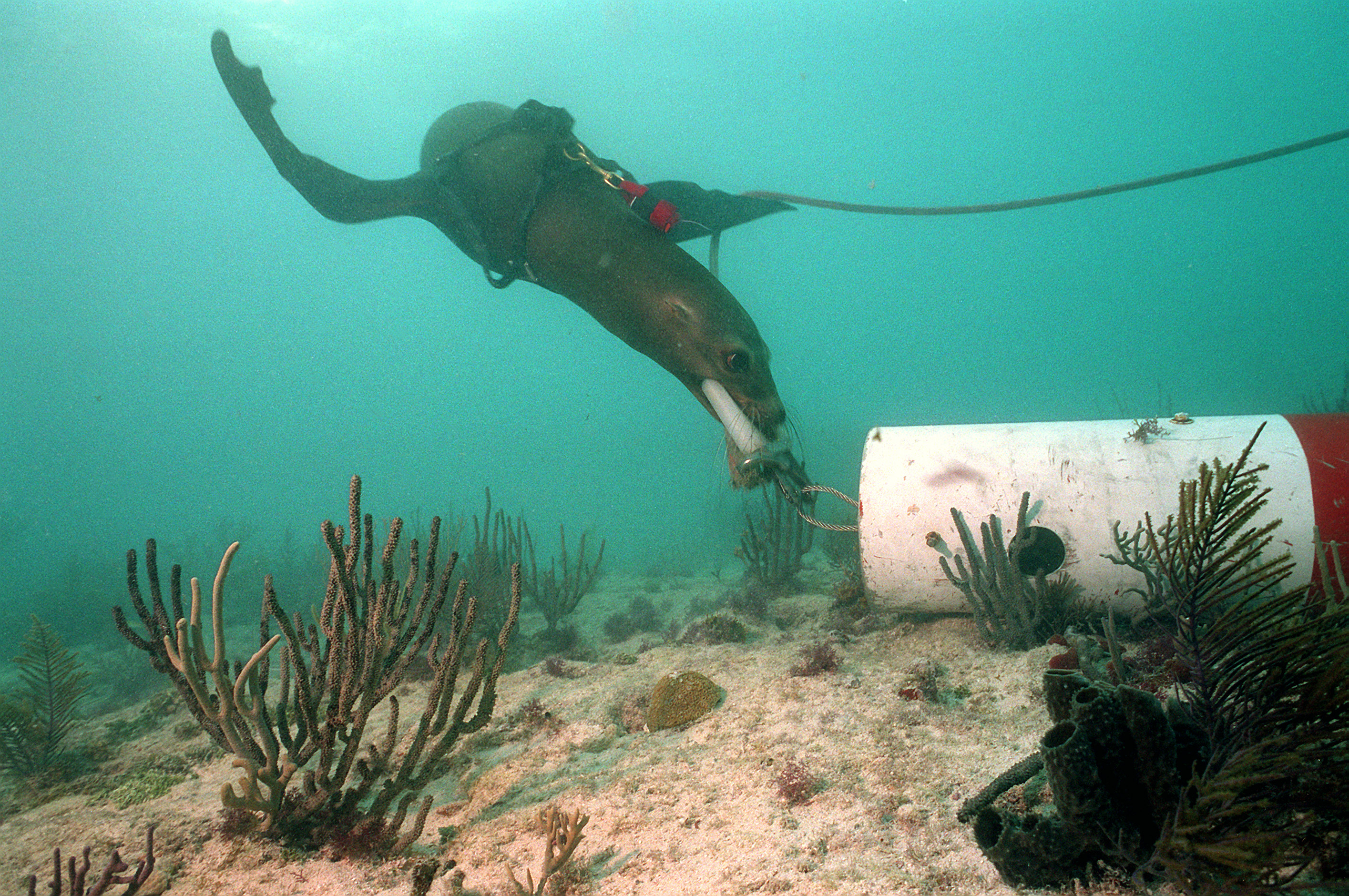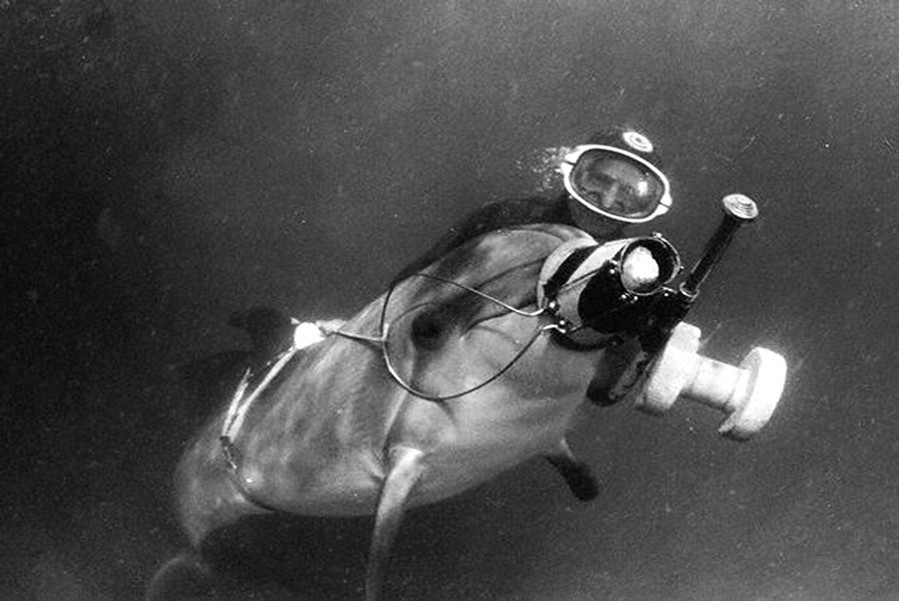
![]()
Intelligence Research Observatory
Naval Warfare & Marine Mammals-An Open Source Intelligence Study
Methodology-OSINT Research
Research and Analysis-S.A. Cavanagh
Research Assistance-Chuck Stevens
Caveat-this open source intelligence study is based on secondary information pulled from internet publications, and as best practice, all sources are cited accurately and academically. Much of the information for this report comes from a highly respected and pioneering OSINT analyst and journalist H.I. Sutton of Covert Shores and his extensive articles published by other reputable outlets. As Sutton is the premier Subject Matter Expert on Naval Warfare OSINT, it is important to acknowledge his expertise, as his work is the basis for most of the open source information available on this topic.

Image courtesy of US Navy
Background & Analysis
Marine Mammal Naval programs are an effective low cost method for securing & protecting important harbors and expensive warships. Navy marine mammal units are known to exist and conduct important maritime work for naval forces in both the USA and Russia. Other nations thought to possess similar marine mammal programs are; Israel, North Korea, and Iran. The US Navy claims to have declassified the marine mammal systems, however this is unlikely. The US navy marine mammal program is thought to be more defensive in nature, while Russian mammals are claimed to be both defensive and combat offensive; however there is little evidence of frogman kills by spear fishing dolphins or suicide vest wearing sea lions attacking battleships. Although plausible marine mammals are trained to kill, most likely they are only used to counter combat swimmers through location and harassment. Dolphins are able to echolocate mines that float or are buried, while sea lions can locate navy practice ordinance in zero visibility and connect recovery lines for retrieval in water as deep as 1000 feet. Russia is known to have trained & most recently deployed dolphins in Syria for warm water warfare. Alternatively Russia is using seals and Beluga whales for arctic reconnaissance and surveillance. De Faakto analysis posits Russian Beluga whales are used to locate, identify and harass spy ships posing as fishing vessels, and then photograph sailors and equipment with cameras fitted to harnesses on the playful whales. GPS marked images are then relayed to Russian intelligence for processing. North Korea appears to have a classified, fledgling marine mammal program evidenced by satellite images of dolphin pens on a naval base and public dolphin attractions for citizens. There is little delineation between the North Korean state and military affairs, which make it plausible that the North Korean navy is using the public dolphin Aquarium for a military training and breeding program. Iran is believed to have a former Soviet marine mammal program; as the story claims, a contractor working to train combat marine mammals for the Soviet navy could not bear to see his animals starve after the collapse of the Soviet Union. The contractor moved his entire program to Iran so that his animals could live and he could continue training mercenary dolphins. Little is known about the outcome of “Iran’s marine mammal navy” however it is possible the program continues because marine animals live extended life spans. Israel is rumored to have “combat dolphins” according to terror organization Hamas. Hamas claims to have captured a “Zionist killer dolphin” with a harnessed “head spear” attached. Much of Hamas claims are propaganda and there is little evidence of any Israeli Navy killer dolphins, especially if the Jewish state acquired dolphins from the US Navy which claim only defensive working animals, according to unclassified reports. It is plausible that Israeli trained dolphin can carry spears or that the former Soviet mercenary dolphin trainer defected to the Jewish state at a later time. Israeli military secrets are well protected and it is unlikely the defense force would declassify the existence of any such program. What is certain is that marine mammal navy warfare programs will continue. Reasons for the longevity of marine animals in the navy, is because the cost is relatively small in comparison to expensive technology that cannot perform to the level that dolphins or seals already do. Frogmen cannot compete with the echolocation ability of dolphins, or the keen underwater eyesight of sea lions. Both mammals are capable of diving 900 ft without decompression stops, or special equipment. The most convincing evidence of how effective marine mammals are comes from testimony of US Navy human SEAL, Kaj Larsen, who said he’ll never forget the first time a dolphin rammed him underwater. “The truth is, it’s really one of the most effective ways to prevent attacks by combat divers, because everything else doesn’t really work,” said Larsen, who first experienced Flipper’s furor during the dive phase of the Basic Underwater Demolition/SEAL course some 20 years ago. While combat divers learn to defeat sonar nets, “we really have no way to defeat a dolphin, you’re in their element,” Larsen said, “and they find you every single time underwater.” Another reason marine mammal warfare will remain is because China is investing heavily in maritime “Mining systems.” This indicates marine mine countermeasures will remain a priority for the US and Russian Navies, as they both see China as a threat to national peace and homeland security. Expensive sensors and water drones are no where nearly effective as dolphins or sea lions, and marine mammals will remain a most valuable maritime security apparatus.

Image of combat seal courtesy of US Navy
What Marine Mammals are used for Naval Warfare?
- Dolphins
- Beluga Whales
- Sea Lions
- Seals
What exactly are Marine Mammals?
- Marine mammals live some or all of their lives in the ocean. Like all mammals, they breathe air through lungs, are warm-blooded, give birth to live young, and nurse babies with milk. Dolphins, whales, sea lions, seals, walruses, and manatees are examples of marine mammals (Naval Undersea Museum, 2024)

Image of Marine Mammals courtesy of laatech.net
Why use Marine Mammals for Navy activities?
Better than Frogman Commandos
- The US Navy wants to move away from its marine mammals and use drones and other new sensors, however dolphins and sea lions can still do their jobs better than that new technology (Business Insider, 2022)
- Sea lions can dive 900 feet, and trained bottlenose dolphins have dived more than 1,000 feet, to locate undersea objects faster and more accurately than navy divers and drone underwater vehicles
- Atlantic bottlenose dolphins and California sea lions displayed the best mix of skills and trainability for the US Navy. Both species excelled at locating objects underwater
- Since the 1960s, marine mammals have performed these missions better then any other tech system
What Tasks do Marine Mammals perform?
- Missions that protect and support Navy Sailors, ships, and bases

Image courtesy of United States Undersea Museum
Mine-hunting
- Dolphins can find mines tethered to the seafloor, resting on the bottom, or fully buried in sediment, the mammal drops a marker buoy near the found mine for human divers to recover and disable
- Although most mines still contain explosives, they pose little danger to dolphins
- Mines detonate by sensing the magnetic presence (disturbance) of steel ships. Marine animals cannot trigger them
- Dolphins have biological sonar that detects mines faster and better than sonar invented by humans (Business Insider, 2022)
:quality(70)/cloudfront-us-east-1.images.arcpublishing.com/archetype/4MA6ZBPEOJGYNMZGBBJP2VKQIA.jpg)
Image courtesy of US Navy
Intruder Defense
- Like security dogs, marine mammals can detect trespassers
- The US Navy’s dolphins and sea lions guard underwater areas like piers, harbors, and ship channels against intruders. They patrol the waters looking for divers and undersea vehicles that could plant weapons or spy on naval bases
- Dolphins and sea lions swim swiftly and stealthily compared to human divers
- A marine mammal can identify and tag an enemy swimmer before the person realizes the animal is even there
- Marine mammals cannot tell the difference between friendly and enemy divers. They are trained to detect any swimmers in an area (Naval Undersea Museum, 2024)

Image courtesy of United States Undersea Museum
Object Recovery
- US Navy sea lions find practice mines and targets that ships and aircraft test in the ocean
- Recovering test equipment saves money and allows reuse
- Sea lions work better then divers and drones
- Training mines and targets contain tracking pingers
- Sea lions search by listening for tones the pingers produce. Once near a target, sea lions use their low-light vision to pinpoint the object’s location
- When a sea lion finds a mine or target, it snaps a recovery line onto an attachment point on the object for retrieval
- In the U.S.’s 1969 Project Deep Ops, two killer whales and a pilot whale—Ahab, Ishmael and Morgan—were trained to retrieve objects that had been lost in the ocean, in conditions too deep for human divers to retrieve, and too rough for machines to handle (JSTOR, 2019)
How Effective are Marine Mammal Programs?
- Kaj Larsen, a former US Navy SEAL, said he’ll never forget the first time a dolphin rammed him underwater
- “The truth is, it’s really one of the most effective ways to prevent attacks by combat divers, because everything else doesn’t really work,” said Larsen, who first experienced Flipper’s furor during the dive phase of the Basic Underwater Demolition/SEAL course some 20 years ago
- BUD/S students’ combat-swimmer missions doubled as anti-combat-swimmer training for the dolphins
- While combat divers learn to defeat sonar nets, “we really have no way to defeat a dolphin, you’re in their element,” Larsen said, “and they find you every single time underwater” (Business Insider, 2023)
What Navies have Marine Mammals Programs?
- United States Navy-dolphins, seals & sea lions
- Former Soviet Union Navy-Beluga whales, dolphins & seals
- Ukraine inherited and operated the former Soviet Union’s marine mammal programs for 23 years after the Soviet Union dissolved (1991)
- Russia took back the naval marine mammal program from Ukraine when Russia annexed the Crimea in 2014, Russia continues to utilize- Beluga whales, dolphins & seals
Latest OSINT on the Russian Navy Marine Mammal Program
Sevastopol Black Sea
Video courtesy of YouTube
- Russia is most likely using the dolphins to protect Sevastopol from attack by enemy swimmers– in this case, Ukrainian naval Special Forces, who might attempt to infiltrate the base and attack ships and facilities with limpet mines and explosive charges (Popular Mechanics, 2020)
Syria & Norway

Image of Tartus Port Syria, Russian Navy Installation thought to be guarded by seals and dolphins courtesy of Global Security.Org
- Russia may have deployed dolphins to the war in Syria
- There are rumors that Russia may have deployed seals in Syria to guard installations
- A Beluga whale that turned up in Norway was likely part of the Russian Navy program
Latest Open Source Information on the US Navy Marine Mammal Program
Video courtesy of YouTube Real Science
- The US Navy wants to move away from its marine mammals and use drones and other new sensors instead
- But dolphins and sea lions can still do their jobs better than that new technology
- While often seen at the surface, both are deep divers. Sea lions can dive 900 feet, and trained bottlenose dolphins have dived more than 1,000 feet
- The Navy Marine Mammal Program’s budget for 2023 provides $40 million, with about $21 million covering “food, medicine, veterinary care, husbandry, and facilities” for the program’s 77 dolphins and 47 sea lions
- About $19 million covers mission costs and research. The program employs 54 Navy civilians and six Army veterinarians, as well as 220 contractors and 22 graduate students or undergraduate volunteers
- While opinions differ about the program’s cost, few question the marine mammals’ capabilities. “It is infinitesimally small [budget] compared with what has been and is being spent on a variety of other types of technology,” said Scott Savitz, a senior engineer at Rand Corporation, a nonpartisan think tank
- The marine mammals “offer so much at a relatively low cost that it seems absurd not to continue to use them, certainly in the near-term (Business Insider 2023)
Video courtesy of YouTube New Horizon
Open Source information-Russian Navy Marine Mammal Programs
- Russia’s program now includes a Black Sea dolphin unit and an Arctic program run by a Russian intelligence agency that uses seals and beluga whales, according to the USNI (NBC News, 2022)
- Russia has been training and deploying marine animals for military purposes since the 1960s
- Throughout the Cold War, the Soviet Union developed marine mammal programs
- The USSR deployed dolphins in warm waters and beluga whales and seals in Arctic regions
- The Soviet navy used Sevastopol as a base from which to train and send dolphins on operations throughout the Cold War (Live Science, 2022)
- Not willing to cede cetacean superiority to the U.S., the Soviet Union tried to make a military marine mammal program for offensive as well as defensive actions. The Soviet program reportedly produced dolphins that were trained to attack with mounted harpoons, as well as “kamikaze dolphins” strapped with explosives that could bomb enemy ships in suicide strikes. It isn’t clear if the Soviet Union’s attack dolphins ever saw combat, but even if they did it’s unlikely they were very successful (NBC News, 2022)
What Navies are thought to have a classified Marine Mammal program?
North Korea
Video Courtesy of YouTube
- Intelligence indicates that NK has had a marine mammal warfare program since 2015
- Dolphin pens made their first appearance at the site of a major naval display in Nampo, a naval base and port city on the west coast
- The animal pens were spotted in satellite imagery in the brown waters between a shipyard and a coal loading pier. This location may still be in use intermittently, possibly for training with the naval units based nearby. But the main activity moved to a site further up the river on the edge of town
- This base, possibly where the dolphins are bred, began its development in October 2016
- The program is likely part of the widespread modernization of the navy that has taken place under North Korean leader Kim Jong Un (USNI, 2020)
- Comparison of satellite images to the marine mammal pens used by the U.S. Navy and Russian Navy suggest that the North Korean pens are likely sized for dolphins
- It is plausible that the pens are some type of fish farm, as North Korea has placed increased emphasis on fish farming in recent years and they are cropping up all over the country, many are run by the armed forces; however a survey of fish farms suggests that these pens are different, and not consistent with other sites in North Korea
- North Korea also trains dolphins for a dolphinarium in the capital, Pyongyang. Given the intertwined nature of its military and civilian apparatus, it is not farfetched to suggest that the naval program benefits from this experience and infrastructure (USNI, 2020)
The Israeli Navy-Open Source Information
Video courtesy of YouTube
2022
- Questions over a rumored Israeli military program resurfaced after Hamas paid tribute to a naval commando credited with capturing a trained killer dolphin (This report of an offensive combat dolphin likely happened in 2015)
- In a video shared on social media, a spokesman for the Palestinian group’s military wing paid tribute to “martyr Abu Anas for discovering the first dolphin used by the enemy to detect our fighter swimmers”
- Thanks to the efforts of its Al Qassam Brigades fighter, “we discovered the first dolphin used by the enemy to chase down our marine forces in the depths of the sea,” the spokesman said
2015
- Hamas claimed in 2015 to have captured an Israeli-trained dolphin it said was spotted making “suspicious movements” off the Gaza coast
- The video contained images of a harness said to have been taken from the dolphin, featuring what appeared to be a harpoon that could have been mounted to the creature’s nose
- Stories of armed dolphins patrolling the waters off Gaza may sound like something in a spy novel, but could Israel really use animals as part of its naval operations?
- Experts told The National the “truth could be stranger than fiction”
- Naval analyst HI Sutton said that though contact between Hamas frogmen and dolphins cannot be confirmed, “It is plausible that Israel has a navy dolphin program”
- The animals “would likely be used to protect key sites from saboteurs and enemy divers,” (National News, 2022)
- Israeli security forces used a dolphin to chase Hamas frogman commandos off the coast of the Gaza Strip, the terrorist organization claimed, according to a report by Al-Quds
Unknown Date
- During an operation that occurred at an unstated time, Hamas naval operatives were chased into the sea by a dolphin equipped with a device capable of killing the terrorist group’s frogmen, an Al-Qassam brigades naval commando spokesperson revealed in a video
- “Killer Zionist dolphins exist, according to a Hamas publication,” tweeted Joe Truzman, research analyst at the Foundation for Defense of Democracies’ Long War Journal
- “Abu Hamza explains that a member of Hamas’ Frogman unit who was killed by Israel during the May conflict found the killer dolphin. The device the alleged killer dolphin was wearing is shown in the publication” (JPost, 2022)

Image from Hamas Terror group claiming to be dolphin harpoon gear used by Israeli elite killer dolphins courtesy of the Times of Israel

Image of Kish Dolphin Complex in Iran-thought to base Iran’s Navy dolphin program-Iran Government
Iran Navy
- In the spring of 2000, a Russian man named Boris Zhurid made a painful, fateful sale
- For years, Zhurid had been training a pack of dolphins to kill for the Soviet Navy, according to the BBC
- he and other experts taught the mammals to target enemy combat swimmers and divers with harpoons strapped to their backs, capture them, and carry mines to enemy ships in suicide attacks (The dolphins could tell the difference between Soviet and foreign subs by how their propellers sounded)
- But when funding for that project ran out—and the Soviet dolphin program transferred to the Ukrainian Navy—Zhurid brought his animals to a private dolphinarium on the Crimean Peninsula, where they performed for tourists. Eventually, however, Zhurid couldn’t afford to feed the dolphins anymore
- “I cannot bear to see my animals starve,” the trainer told the Russian newspaper Komsomolskaya Pravda. “We’re out of medicine, which costs thousands of dollars, and have no more fish or food supplements”
- So Zhurid bit the bullet and sold his beloved dolphins—along with walruses, sea lions, seals, and a white beluga whale—to a custom-built oceanarium in Iran, where, the BBC reported, the trainer would be “continuing his scientific research.” Zhurid didn’t say what he and his aquatic mercenaries would do in their new home, but he did tell Komsomolskaya Pravda that he was “prepared to go to Allah, or even to the devil, as long as my animals will be OK there”
- We don’t know what ever happened to the dolphins in the Persian Gulf since that March 2000 sale Dolphins do have a lifespan of 50 years or more, as Blake Stilwell of Military points out, so the original assassins could still very much be alive. Zhurid “could also have trained more killer dolphins for use against Western shipping,” Stilwell speculates
- If Iran is indeed relying on the mammals for reconnaissance, the country isn’t alone. Russia seized control of its dormant military dolphin program in 2014 after the annexation of Crimea. In 2016, the Russian Defense Ministry was actively scouting dolphins “with perfect teeth,” while last year, Norwegian fishermen spotted a whale wearing a harness from St. Petersburg, suggesting the Russian Navy was recruiting belugas for undersea warfare (Popular Mechanics, 2020)
Marine Mammals Natural Talents
Sea Lion
- Sea lions have very good low-light visibility underwater and great directional hearing so they can find divers in the dead of night, in dark, murky water
- They can find them no problem and then tag them, so that then the security personnel can go find out who that person is
Dolphins
- The dolphins have very high-level biological sonar, so finding objects like mines, are no problem, they can be buried in the ocean floor or floating around or anywhere (ABC News, 2011) (CIA, 1976)
Beluga Whales
- Russian navy assets include Beluga Whales, for surveillance and reconnaissance (Live Science, 2022)
Caveat-De Faakto intelligence analysis hypothesizes that Russia has trained “Friendly & Playful Beluga Whales” to target small fishing vessels in military areas of operations to locate and identify espionage, surveillance and spy assets disguised as fishing boats, when the playful whale disrupts the crew and the vessel of interest, the sailors and equipment visible on the boat are photographed and the intelligence images are relayed back to Russian Naval Intelligence for analysis. This is posited by the harnesses and camera gear attached to the Beluga Whales, marked Russian property
Seals
- Seals are pinnipeds the same species as sea lions, however they are different as Sea lions are brown, bark loudly, “walk” on land using their large flippers and have visible ear flaps. Seals have small flippers, wriggle on their bellies on land, and lack visible ear flaps
- Although seals are mentioned often in literature as navy mammals, there is little information on what seals do in a warfare capacity
- Sea lions appear to be the marine mammal of choice for the US Navy; however seals appear to have been used for retrieval of objects
- It is plausible that seal mammals tasks are both tactical & classified and therefore not much information is available in open source
- Given their similarities it appears Russia uses seals to guard harbors and ships, much as the US Navy utilizes sea lions
Marine Mammal Navy Warfare Chronology of Events, Combat & Intelligence Reports
2023

- U.K. Ministry of Defense announced that the agency’s intelligence found that it is “likely” Russia has trained combat dolphins to defend its Navy base in Sevastopol
- The Russian Navy has been enhancing security at its base in the city in occupied Crimea since last summer
- Imagery of the base reveals an increasing number of floating mammal pens, likely housing bottlenose dolphins
- This includes at least four layers of nets and booms across the harbor entrance
- These defenses have likely also been augmented, by an increased number of trained marine mammals
- Russia has previously used Beluga whales and seals in Arctic regions for navy surveillance missions, according to the U.K. MOD (USA Today, 2023)
2019
- Norwegian fishermen reported a surprisingly tame beluga whale, had been harassing their boats while wearing a harness that read: “Equipment of St. Petersburg
- The whale, wearing a GoPro camera harness, was nicknamed Hvaldimir (Popular Mechanics, 2020)
2018
- Russia’s militarized marine mammals were spotted in 2018
- Satellite imagery revealed that Russia had deployed dolphins at a base in Tartus, Syria, during the Syrian war (Live Science, 2022)
2003–2005: OPERATIONS ENDURING FREEDOM AND IRAQI FREEDOM
- United States Navy Dolphins and sea lions safeguarded ships by searching for enemy swimmers and mines
2001–2003: OPERATION NOBLE EAGLE
- United States Navy Dolphins patrolled waters outside U.S. military installations and other potential terrorist targets
1986–1987: IRAN-IRAQ WAR
- United States Navy dolphins protected the command ship USS LaSalle (AGF 3) in the Persian Gulf
1970–1971: VIETNAM WAR
- United States Navy Dolphins and sea lions guarded harbors and ships
1963
- The U.S. Navy created the Marine Mammal Program in 1963 to see if animals could perform tasks difficult or dangerous for human divers. Scientists assessed more than 20 species of dolphins, whales, sea lions, seals, sharks, and marine birds to determine their aptitude for Navy missions. Atlantic bottlenose dolphins and California sea lions displayed the best mix of skills and trainability (Naval Undersea Museum, 2024)


Resources
Marine Mammals the Navy’s Super Searchers-Naval Undersea Museum-Author Unknown Staff (2024) https://navalunderseamuseum.org/marinemammals2/
North Korea may be training military dolphins, according to new satellite images-National Post-Staff Writers (2020) https://nationalpost.com/news/world/north-korea-may-be-training-military-dolphins-according-to-new-satellite-images
Does Iran Have Secret Armed Dolphin Assassins? Popular Mechanics-Andrew Daniels (2020) https://www.popularmechanics.com/military/weapons/a30500130/iran-military-dolphins/
Killer Zionist dolphins? Hamas claims they exist-Jerusalem Post-Staff Writers (2022) https://www.jpost.com/omg/article-692167#google_vignette
Do trained ‘killer’ dolphins really patrol Israeli waters? National News- Arthur Scott-Geddes & Robert Tollast (2022) https://www.thenationalnews.com/mena/2022/01/12/do-trained-killer-dolphins-really-patrol-israeli-waters/
Why Russia is using dolphins to guard its navy ships. No, that’s not a code name-NBC News-Adam Larson (2022) https://www.nbcnews.com/think/opinion/russias-use-dolphins-guard-navy-ships-isnt-farfetched-rcna26523
It Sure Looks Like Russia Is Using Trained Military Dolphins Against Ukraine-Popular Mechanics- KYLE MIZOKAMI (2022) https://www.popularmechanics.com/military/weapons/a39853134/russia-trained-military-dolphins-black-sea/
Russia is using military-trained dolphins in the Black Sea, according to satellite images –Live Science-Ben Turner (2022) https://www.livescience.com/russians-using-military-dolphins-satellite
UK Officials say Russia is likely training combat dolphins for Ukraine War-USA Today-Isabella Butera (2023) https://www.usatoday.com/story/news/world/2023/06/26/russia-dolphins-ukraine-war-uk/70356695007/
The Real Navy Seals – and Sea Lions and Dolphins and Whales-ABC News-ABC News writers (2011) https://abcnews.go.com/Blotter/navy-sea-lions-dolphins-find-mines/story?id=13693585
Capability of the Soviets to Train Marine Mammals for a Military Operational System-Central Intelligence Agency USA-Directorate for Science and Technology Office of Science and Technology-Author Classified (1976) https://www.cia.gov/readingroom/docs/DOC_0000969804.pdf
New Evidence Suggests North Korea has a Naval Marine Mammal Program-US Naval Institute-H I SUTTON (2020) https://news.usni.org/2020/11/12/new-evidence-suggests-north-korea-has-a-naval-marine-mammal-program
For 60 years, the US Navy has been training dolphins and sea lions to keep rivals away from its most sensitive hardware-Business Insider-Gidget Fuentes (2022) https://www.businessinsider.com/us-navy-trains-dolphins-sea-lions-to-guard-sensitive-hardware-2022-12
Navy Seals: Why the Military Uses Marine Mammals-JSTOR Daily-Farah Mohammed (2019) https://daily.jstor.org/navy-seals-why-the-military-uses-marine-mammals/







